University of Otago
Māori:Ōtākou Whakaihu Waka | |
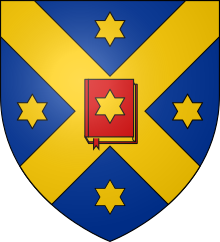 | |
| Motto | Latin:Sapere aude |
|---|---|
Motto in English | Dare to be wise |
| Type | Publicresearchcollegiate university |
| Established | 1869; 152 years ago |
| Endowment | NZD$279.9 million (31 December 2021)[1] |
| Budget | NZD $756.8 million (31 December 2020)[2] |
| Chancellor | Stephen Higgs |
| Vice-Chancellor | Grant Robertson[3] |
Academic staff | 1,744 (2019)[4] |
Administrative staff | 2,246 (2019)[4] |
| Students | 21,240 (2019)[4] |
| Undergraduates | 15,635 (2014)[4] |
| Postgraduates | 4,378 (2014)[4] |
| 1,579 (2019)[4] | |
| Location | ,, New Zealand (Māori:Ōtepoti, Ōtākou, Aotearoa) 45°51′56″S170°30′50″E/ 45.86556°S 170.51389°E |
| Campus | Urban/University town 45 hectares (110 acres) |
| Student Magazine | Critic |
| Colours | Dunedin Blue and Gold |
| Affiliations | MNU |
| Website | https:// otago.ac.nz |
 | |
TheUniversity of Otago(Māori:Ōtākou Whakaihu Waka[5]) is apublicresearchcollegiate universitybased inDunedin,Otago,New Zealand. Founded in 1869, Otago is New Zealand's oldest university and one of the oldest universities inOceania.[6]
The university was created by a committee led byThomas Burns,[7]and officially established by an ordinance of theOtago Provincial Councilin 1869.[8]Between 1874 and 1961 the University of Otago was a part of the federalUniversity of New Zealand,and issued degrees in its name.[9]
Otago is known for its vibrant student life, particularly itsflatting,which is often in old houses. Otago students have a long-standing tradition of naming their flats.[10][11][12]The nickname for Otago students, "Scarfie," comes from the habit of wearing ascarfduring the cold southern winters.[13]The nickname "Scarfie" has morphed into the nickname "Breather" in recent years.[14][15]The university's graduation song,Gaudeamus igitur, iuvenes dum sumus( "Let us rejoice, while we are young" ), acknowledges students will continue to live up to the challenge, if not always in the way intended. The university's student magazine,Critic,is New Zealand's longest running student magazine.
History
[edit]
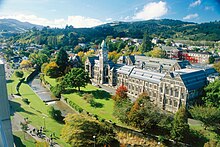

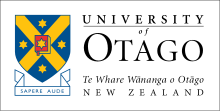
19th century
[edit]TheOtago Association's plan for the European settlement of southern New Zealand, conceived under the principles ofEdward Gibbon Wakefieldin the 1840s, envisaged a university.
Dunedin leadersThomas BurnsandJames Macandrewurged theOtago Provincial Councilduring the 1860s to set aside a land endowment for an institute ofhigher education.[16]An ordinance of the council established the university in 1869, giving it 100,000 acres (400 km2) of land and the power to grant degrees in Arts, Medicine, Law and Music.[17]Burns was named Chancellor but he did not live to see the university open on 5 July 1871.[7][16]
The university conferred just one degree, toAlexander Watt Williamson,before becoming an affiliated college of the federalUniversity of New Zealandin 1874. With the dissolution of the University of New Zealand in 1961 and the passage of the University of Otago Amendment Act 1961, the university resumed its power to confer degrees.[17]
Originally operating fromWilliam Mason's Post Office building onPrinces Street,it relocated toMaxwell Bury'sClocktowerand Geology buildings in 1878 and 1879.[17]This evolved into theClocktower complex,a striking group ofGothic revivalbuildings at the heart of the campus. These buildings were inspired by the then-new main building at theUniversity of Glasgowin Scotland.
Otago was the first university in Australasia to permit women to take a law degree.[18]Ethel Benjamingraduated LLB in 1897. Later that year she became the first woman in theBritish Empireto appear as counsel in court.[19]
20th century
[edit]The University of Otago helped train medical personnel as part of the Otago University Medical Corps. They supplied or trained most of theNew Zealand Army's doctors and dentists during theFirst World War.[20]
ProfessorRobert Jackmade the first radio broadcast in New Zealand from the physics department on 17 November 1921.[21]
Queen Elizabeth IIvisited the university library with theDuke of Edinburghon 18 March 1970. This was the first time the royals completed informal "walkabouts" to meet the public, and it was the first visit ofPrince Charles(then 21 years old) andPrincess Anne(19 years) to this country.[22]
21st century
[edit]In May 2010 the university joined theMatariki Network of Universities(MNU) together withDartmouth College(US),Durham University(UK),Queen's University(Canada),University of Tübingen(Germany),University of Western Australia(Australia) andUppsala University(Sweden).[23]
Beginning in 2015 university Vice-Chancellor Harlene Hayne and Pro-Vice-ChancellorTony Ballantyneimplemented cuts in academic and support staff which generated enduring controversy. In this contextThe New Zealand Heraldcharacterised the university's 'climate' as one of top-down 'suppression and fear' for its employees. TheOtago Daily Timesreported on 'demoralised teachers and researchers' who were 'locked in pain and anger at what their institution had become' and later opined that 'the university desperately needs a reset'.[24][25][26][27][28][29]In 2020 the University of Otago announced that Hayne would be leaving the university and that Ballantyne would be given a new role, namely, leading the Division of External Engagement to attend to alumni relations and liaising with secondary schools, among other matters.[30][31]
In December 2020, eight graduation ceremonies scheduled for that month were disrupted following threats to carry out a firearms and explosives attack on students attending graduation ceremonies scheduled for 7 and 8 December. On 18 December, a 22-year-old woman appeared in the Auckland District Court on charges of threatening harm to people or property. Court documents have described the threat as being of a "magnitude surpassing the15 March Christchurch mosque massacres."[32][33]On 14 July 2021, the woman, who has interim name suppression, admitted to threatening to carry out a firearms and explosives attack against Otago students. Her lawyer applied for a discharge without conviction.[34]On 12 May 2022, the woman was sentenced to five months community detention and nine months intensive supervision. According to the University Chancellor, the bomb threat and subsequent cancellation of eight graduation ceremonies caused the University NZ$1.3 million.[35]
In mid-April 2023, Otago University reported that it was facing a NZ$60 million deficit due to declining student enrollments and a shortfall in government funding. In response, Acting Vice-Chancellor ProfessorHelen Nicholsonstated that the university was considering laying off several hundred staff members including academics.[36][37]This marked the first time since its founding in 1878 that the university has faced a major debt crisis. According to theOtago Daily Times,the university had only started borrowing in mid-December 2022, incurring a year-end debt of NZ$30 million. While the university was able to come out of debt in January 2023 following a regular injection of government funding, the university subsequently incurred more debt in 2023 due to its capital programme of refurbishing existing buildings and building new buildings.[38]In response, students staged a protest against the proposed cuts.Otago University Students Associationpresident Quintin Jane also called onEducation MinisterJan Tinettito increase funding for universities.[39]In late May 2023, theOtago Daily Timesreported that the university had declined to inform staff of its NZ$60 million budget shortfall in November 2022.[40]In late June 2023, the Government announced a NZ$128 million funding injection for degree-level and postgraduate programmes for New Zealand universities and other tertiary institutions. In response, acting Vice-Chancellor Nicholson stated that the university would still proceed with job cuts since the funding would only come into effect from 2024 onwards.[41]
In March 2024,Grant Robertsonwas designated as the next Vice-Chancellor, commencing July 2024.[42]This announcement was accompanied by a 'major' 'almost wholesale' replacement of the university leadership.[42]While University Chancellor Stephen Higgs and the university council supported Robertson's appointment, there was mixed reception from donors. While some were supportive, several objected to appointing a former politician due to his non-academic background and record as Finance Minister. Several alumni also withheld donations and funding to Otago University following Robertson's appointment.[43]In mid May 2024, theOtago Daily Timesreported that donations to the University's Foundation Trust had declined from NZ$12.25 million in 2022 to NZ$7.09m in 2023. University development and alumni relations office director Shelagh Murray attributed the decline in donor funding to the ongoing impact ofCovid-19,the economic recession and the cost-of-living crisis on individuals and businesses.[44]
Coat of arms
[edit]
|
|
In mid-March 2023, the university unveiled a new proposed logo replacing the traditional coat of arms with a symbol and a newMāoriname for the institution as part of its Vision 2040 strategy.[46]The process was spearheaded byTony Ballantyneand the university'sDivision of External Engagement.The proposed symbol is intended to symbolise the Otakou channel in Otago harbour while the coat of arms will be retained for ceremonial settings such as graduation events. The proposal also involves changing the current Māori name fromTe Whare Wānanga o OtāgotoŌtākou Whakaihu Waka( "A Place of Many Firsts" ). Acting Vice-Chancellor Professor Helen Nicholson stated that the proposed logo and name change was intended to create a visual identity that reflected modern Aotearoa New Zealand. The university also launched a consultation process for staff, students and alumni that will conclude on 16 April 2023.[47][48]On 17 March 2023, anOtago Daily Timessurvey found that 77% (1,908) of 2,479 respondents opposed the proposed logo change.[49]The process was also criticised for costing about $700,000 whilst large numbers of academic staff were made redundant on the grounds of budgetary shortfalls.[50][51]
On 11 July 2023, the University council voted to proceed with the logo and alternate Māori name change following a consultation process with staff, students, and alumni. Three quarters of respondents voted to replace the coat of arms with the O-shaped symbol while two thirds voted to change the Māori name fromTe Whare Wānanga o OtāgotoŌtākou Whakaihu Waka( "A Place of Many Firsts" ). The new logo will be rolled out from March 2024 over a 12-month period at a cost of NZ$1.3 million.[52][53]
Campuses
[edit]The University of Otago's main campus is in Dunedin, which hosts the Central Administration as well as its Health Sciences, Humanities, Business School, and Sciences divisions.[54]The architectural grandeur and accompanying gardens of the main campus in Dunedin led to its being ranked as one of the world's most beautiful university campuses by the British newspaperThe Daily Telegraphand American online news websiteThe Huffington Post.[55][56]In addition, the university has four satellite campuses inAuckland,Wellington,Christchurch,andInvercargill.[54]
- TheChristchurch campusis based at the Christchurch School of Medicine and Health Science. It also provides medical and physiotherapy clinical training programs, research, distance education, and postgraduate programs.[54][57]
- TheWellington campusis based at the Wellington School of Medicine and Health Science. It also provides medical and physiotherapy clinical training programs, research, distance education, and postgraduate programs.[54][58]
- The Auckland campus is based at the Auckland Centre on Queen. The Auckland Centre provides various teaching and distance learning courses and serves as a liaison with the wider Auckland community and alumni.[59]
- The Southland Campus (Ahuahu Te Mātauranga) is a branch of theUniversity of Otago College of Education.The campus provides a range of early childhood, primary, primary bilingual, and secondary teacher education programs.[54][60]
- The University of Otago's Department of Marine Science also operates thePortobello Marine Laboratoryin theOtago peninsula.[61]
Merger with Dunedin College of Education
[edit]The University of Otago and theDunedin College of Education(a specialist teacher training institution) merged on 1 January 2007. TheUniversity of Otago College of Educationis now based on the college site, and includes the college's campuses inInvercargillandAlexandra.Staff of the university's Faculty of Education relocated to the college site. A merger had been considered before, however the present talks progressed further, and more amicably, than previously.
Libraries
[edit]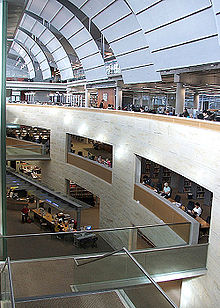
The University of Otago has nine libraries: six based in Dunedin on the main university campus, the education library in Southland, plus two medical libraries in Wellington and Christchurch.[62]All libraries have wireless access.[63]
Central Library
[edit]The Central Library is part of the Information Services Building and has over 2000 study spaces, 130 computer terminals, and laptop connections at 500 desks. It has Te Aka a Tāwhaki, a collection of Māori resources,[64]and the Special Collections consisting of about 9,000 books printed before 1801. In total, the Central Library has over 800,000 print and electronic materials relating to the arts and humanities, commerce, education, physical education, social sciences, and technology.[65]It was designed by the American architecture firmHardy Holzman Pfeifferand opened in 2001, replacing what was previously a 1960s-era modernist building.
Robert Stout Law Library
[edit]TheRobert Stout Law Libraryis the university's law library and is based in the Richardson Building.[66]
Health Sciences Library
[edit]The Health Sciences Library[62]is in the Sayers Building, opposite the main entrance toDunedin Hospital.The Health Sciences Library book collection only includes the last 10 years of content, but does have over 150,000 volumes, the vast majority of which are in storage. There is seating for over 400.[citation needed]
Science Library
[edit]The Science Library[62]is at the north end of the campus in the Science III building, with seating for approximately 500.[citation needed]
Hocken Collections
[edit]TheHocken Collectionsis a research library, archive, and art gallery of national significance which is administered by the University of Otago. The library's specialist areas include items relating to the history of New Zealand and the Pacific, with specific emphasis on theOtagoandSouthlandregions. The Hocken Collections was established in 1910 when Dunedin philanthropistThomas Hockendonated his entire private collection to the University of Otago. It currently houses over 8,000 linear metres of archives and manuscripts. It is currently situated at the site of the former Otago Co-operative Dairy Company factory on Anzac Avenue, east of the main campus.[65][67]
Robertson Library
[edit]TheRobertson Libraryis the university's education library and is jointly run by the University of Otago'sCollege of EducationandOtago Polytechnic,which is also located near the university's Dunedin campus.[68]
Other libraries
[edit]The Wellington Medical and Health Sciences Library and the Canterbury Medical Library provide services to University of Otago students and staff, and the staff of the local District Health Boards.[69][70]The university's Southland Campus also has a library.[62]
Organisation and administration
[edit]

The university is divided into four academic divisions:
- Division of Humanities
- Division of Health Sciences
- Division of Sciences
- Otago Business School
For external and marketing purposes, the Division of Commerce is known as the Otago Business School, as that is the term commonly used for its equivalent in North America. Historically, there were a number of schools and faculties, which have now been grouped with stand alone departments to form these divisions.
In addition to the usual university disciplines, theUniversity of Otago Medical School(founded 1875) is one of only two medical schools in New Zealand (with component schools inDunedin,ChristchurchandWellington); and Otago is the only university in the country to offer training in Dentistry. Other professional schools and faculties not found in all New Zealand universities include Pharmacy, Physical Education, Physiotherapy, Medical Laboratory Science, and Surveying. It was also home to the School of Mines, until this was transferred to theUniversity of Aucklandin 1987. Theology is also offered, traditionally in conjunction with theSchool of Ministry, Knox College,andHoly Cross College, Mosgiel.
There are also a number of service divisions including:
- External Engagement Division
- Financial Services Division
- Human Resources Division
- Information Technology Services Division
- Property Services Division
- Research & Enterprise Division
- Student Services Division
Student body
[edit]This sectionmay contain an excessive amount of intricate detail that may interest only a particular audience.(September 2020) |
Admissions
[edit]| Enrolment By Qualification Type[71] | 2019 | 2018 | 2017 | 2016 | 2015 | 2014 | 2013 | 2012 | 2011 | 2010 | 2009 | 2008 | 2007 | 2006 | 2005 | 2004 | 2003 |
|---|---|---|---|---|---|---|---|---|---|---|---|---|---|---|---|---|---|
| Doctoral | 1,579 | 1,541 | 1,501 | 1,411 | 1,387 | 1,389 | 1,361 | 1,377 | 1,259 | 1,258 | 1,206 | 1,104 | 1,048 | 935 | 829 | 755 | 723 |
| Masters' | 1,469 | 1,360 | 1,261 | 1,287 | 1,224 | 1,214 | 1,216 | 1,281 | 969 | 979 | 921 | 874 | 838 | 1,052 | 1,108 | 1,060 | 994 |
| Postgraduate Diplomas and Certificates | 1,591 | 1,691 | 1,762 | 1,654 | 1,542 | 1,388 | 1,383 | 1,477 | 1,541 | 1,660 | 1,620 | 1,566 | 1,435 | 1,507 | 1,378 | 1,353 | 1,345 |
| Graduate Diplomas | 192 | 215 | 243 | 294 | 314 | 388 | 416 | 426 | 475 | 487 | 405 | 317 | 494 | 204 | 392 | 314 | 298 |
| Bachelor's with Honours | 396 | 404 | 366 | 385 | 451 | 434 | 460 | 524 | 873 | 854 | 843 | 723 | 750 | 736 | 769 | 771 | 763 |
| Bachelor's Ordinary | 14,728 | 14,677 | 14,448 | 14,598 | 14,559 | 15,136 | 15,489 | 15,762 | 15,593 | 15,780 | 15,359 | 13,347 | 13,136 | 12,868 | 12,939 | 12,711 | 12,186 |
| Undergraduate Diplomas and Certificates | 14 | 17 | 20 | 29 | 39 | 65 | 73 | 92 | 116 | 152 | 169 | 133 | 265 | 216 | 239 | 318 | 344 |
| Certificate of Proficiency | 1,576 | 1,455 | 1,492 | 1,493 | 1,442 | 1,284 | 1,228 | 1,171 | 1,326 | 1,450 | 1,419 | ? | ? | ? | ? | ? | ? |
| Interest Only | 13 | 5 | 11 | 1 | 4 | 10 | 0 | 0 | ? | 223 | 150 | ? | ? | ? | ? | ? | ? |
| Foundation Studies | 263 | 298 | 305 | 292 | 316 | 300 | 303 | 266 | 254 | 273 | 282 | ? | ? | ? | ? | ? | ? |
| Total | 21,240 | 21,108 | 20,838 | 20,814 | 20,601 | 20,942 | 21,113 | 21,416 | 21,728 | 22,139 | 21,507 | 20,752 | 20,665 | 19,853 | 20,057 | 19,674 | 18,844 |
| Gender of Students[72] | 2019 | 2018 | 2017 | 2016 | 2015 |
|---|---|---|---|---|---|
| Female | 12,711 | 12,588 | 12,272 | 12,147 | 11,879 |
| Male | 8,510 | 8,519 | 8,565 | 8,665 | 8,720 |
| Gender diverse | 19 | 1 | 1 | 2 | 2 |
| Total | 21,240 | 21,108 | 20,838 | 20,814 | 20,601 |
| Ethnicity of Students[73] | 2019 | 2018 | 2017 | 2016 | 2015 | 2014 | 2013 | 2012 | 2011 | 2010 | 2009 | 2008 | 2007 | 2006 | 2005 | 2004 |
|---|---|---|---|---|---|---|---|---|---|---|---|---|---|---|---|---|
| European/Pākehā | 71.5% | 71.4% | 72.4% | 73.1% | 73.4% | 74.3% | 74.3% | 74.8% | 75.0% | 75.6% | 75.7% | 76.8% | 68.4% | 68.3% | 69.1% | 69.5% |
| Māori | 10.3% | 9.9% | 9.3% | 8.9% | 8.5% | 8.5% | 8.0% | 7.8% | 7.6% | 7.6% | 7.5% | 7.3% | 6.9% | 6.4% | 6.2% | 6.1% |
| Asian | 20.3% | 20.5% | 19.8% | 19.2% | 18.8% | 18.3% | 18.6% | 18.3% | 17.9% | 17.2% | 16.9% | 16.0% | 15.6% | 16.5% | 16.1% | 15.2% |
| Pacific Islanders | 5.0% | 4.7% | 4.5% | 4.2% | 3.9% | 3.6% | 3.2% | 3.1% | 3.1% | 3.1% | 3.0% | 2.8% | 2.6% | 2.6% | 2.5% | 2.5% |
| Middle Eastern / Latin American / African | 3.7% | 3.6% | 3.4% | 3.4% | 3.6% | ? | ? | ? | ? | ? | ? | ? | ? | ? | ? | ? |
| Other / unknown | 3.8% | 3.7% | 3.9% | 3.7% | 3.6% | 3.2% | 3.3% | 2.9% | 2.9% | 2.5% | 5.3% | 4.4% | 6.5% | 6.2% | 6.1% | 6.6% |
Academics
[edit]Distinctions
[edit]This sectionneeds additional citations forverification.(October 2017) |
Many Fellowships add to the diversity of the people associated with "Otago". They include:
- Robert Burns Fellowship(literature)
- Caroline Plummer Fellowship in Community Dance
- Charles Hercus Fellowship
- Claude McCarthy Fellowship
- Foxley Fellowship
- Frances Hodgkins Fellowship(art)
- Henry Lang Fellowship
- Hocken Fellowship
- Mozart Fellowship(music)
- THB Symons Fellowship
- William Evans Visiting Fellowship
In 1998, the physics department gained some fame for making the firstBose–Einstein condensatein theSouthern Hemisphere.
The 2006 Government investigation into research quality (to serve as a basis for future funding) ranked Otago the top University in New Zealand overall, taking into account the quality of its staff and research produced. It was also ranked first in the categories of Clinical Medicine, Biomedical Science, Law, English Literature and Language, History and Earth Science. The Department of Philosophy received the highest score for any nominated academic unit. Otago had been ranked fourth in the 2004 assessment.
In 2006, a report released by the Ministry of Research, Science and Technology found that Otago was the most research intensive university in New Zealand, with 40% of staff time devoted to research and development.[74]
Journal "Science" has recommended worldwide study of Otago's Biochemistry database "Transterm",which hasgenomicdata on 40,000 species.[75]
Rankings
[edit]| University rankings | |
|---|---|
| Global – Overall | |
| ARWUWorld[76] | 401–500 (2023) |
| QSWorld[77] | 214 (2025) |
| THEWorld[78] | 301–350 (2024) |
| USNWRGlobal[79] | =247 (2023) |
The University of Otago is consistently ranked in the top 1% of universities in the world.[80][81]The university has also been rated 5-Stars Plus by QS Stars in theQS World University Rankings.This is the maximum rating achievable under the QS Stars System, which takes into account the quality of Otago's facilities, teaching, graduate employability, internationalisation, and inclusiveness.[82] Besides having 5 subjects in the top 50 in the world, the University of Otago has 10 subjects ranked between 51st and 100th inQS World University Rankings.As well as having 15 subjects in the top 100 in the world, Otago has another 7 subjects in the top 101 to 150 band, and 6 subjects in the top 151 to 200 band.[83]In 2015, the University of Otago became the first New Zealand university to have a course in a QS Top 10 list, being ranked 8th in Dentistry.[84]
| World university rankings | |||
|---|---|---|---|
| Quacquarelli Symonds (QS)[85][86] | Academic Ranking of World Universities | Times Higher Education | |
| 2021 | 184 | 301–400 | 201–250 |
| 2020 | 176 | 301–400 | 201–250 |
| 2019 | 175 | 301–400 | 201–250 |
| 2018 | 151 | 301–400 | 201–250 |
| 2017 | 173 | 301–400 | 201–250 |
| 2016 | 169 | 201–300 | 201–250 |
| 2015 | 173 | 201–300 | 251–275 |
| 2014 | 159 | 201–300 | 226–250 |
| 2013 | 155 | 201–300 | 226–250 |
| 2012 | 133 | 201–300 | 201–225 |
| 2011 | 130 | 201–300 | 201–225 |
| 2010 | 135 | 201–300 | 200+ |
| 2009 | 125 | 201–302 | NA |
| 2008 | 124= | 201–302 | NA |
| 2007 | 114= | 305–402 | NA |
Residential colleges
[edit]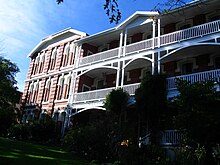
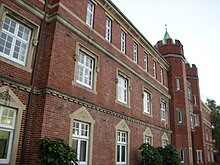
The University of Otago owns, or is in affiliation with, fourteenresidential colleges,which provide food, accommodation, social and welfare services. Most of these cater primarily for first year students, though some have a sizable number of second and higher year undergraduates, as well as occasionally a significant postgraduate population. While some teaching is normally undertaken at a college, this generally represents a small percentage of a resident's formal tuition.
Most colleges actively seek to foster a sense of community and academic achievement amongst their members through, variously,intercollegiate competitions,communal dining, apartment groups, traditionalism, independent students' clubs, college events and internal sporting and cultural societies.
The colleges are geographically spread over the Dunedin urban area:
- Aquinas College
- Arana College
- Caroline Freeman College
- Carrington College
- Cumberland College
- Hayward College
- Knox College
- Salmond College
- Selwyn College
- St Margaret's College
- Studholme College
- Te Rangi Hiroa College
- Toroa College
- University College
In mid October 2019, the University of Otago announced that it would be building a new 450-room residential college called Te Rangi Hiroa, which will replace the current Te Rangi Hiroa College along Cumberland Street. The new college is estimated to cost NZ$90 million and is located on the corner of Albany and Forth Streets near the Dunedin campus.[87][88]
Student life
[edit]O-Week
[edit]
'O-Week' orOrientation Weekis the Otago equivalent ofFreshers' Week.New students are most commonly known by their seniors as 'freshers' or simply as 'first-years'. O-week is organised by theOtago University Students' Associationand involves competitions such as 'Fresher of the Year' whereby several students volunteer to carry out a series of tasks throughout the week before being voted to win. Other competitions include that of different faculties facing off with each other. The OUSA also organises events each night including various concerts, a comedy night, hypnotist plus bigger events atForsyth Barr Stadium.Typically there is a Highlanders rugby game scheduled during the week. Local bars organise events also with a range of live music and promotional deals. Historically events have included the Cookathon and a Miss O-Week competition hosted by The Outback.[89]The Cookathon was held by a local pub (the Cook) with the premise that your first drink costs you about $20 which gives you a t-shirt, three meal vouchers and reduced price on drinks then you spend the rest of the day binge drinking and 'telephoning' the occasional jug with mates.[90]
- Traditions
Each year the first years are encouraged to attend thetoga paradeand party dressed in white sheets wrapped as togas. Retailers called for an end of the parade after property damage and disorder during the 2009 event.[91][92]However, the OUSA took it upon themselves to reintroduce this tradition, with a festival like event taking place at the stadium. 2012 Toga Party saw an unofficial world record. A clocktower race also occurs, in the style ofChariots of Fire.Students must race round the tower and attached building, beginning on the first chime of the clock at noon and completing before the chimes cease. UnlikeChariots of Fire,the task is possible with a couple of students completing each year.
Behavioural issues
[edit]Student behaviour is a major concern for both the university administration and Dunedin residents in general. Concerns over student behaviour prompted the university to introduce a Code of Conduct (CoC) which its students must abide by in 2007. The introduction of the CoC was accompanied by the establishment of the dedicated 'Campus Watch' security force to keep tabs on crime and anti-social behaviour on campus and in the student neighbourhoods nearby. Campus Watch reports directly to the university's Proctor.
- Riots
Riots took place in 2006, 2007, 2008 and 2009 related to events surrounding theUndie 500car rally organised by students from Canterbury University. Other student social events during the year such as the Toga Parade and the Hyde Street Keg Race are also notable for attracting police attention, but not to the scale of the Undie riots. In 2012 there were 80 people treated by emergency services and 15 arrests by police after theHyde Street partywent out of control.[93][94]
- Protest
Otago students are notable for protesting over contentious political issues in nearly every decade. In the 1960s students at Otago who were involved with the Progressive Youth Movement led protests against theVietnam War.In the 1960s mixed flatting (males and females were prohibited from sharing housing up to that time) was contested in various creative ways by Otago students.[95]On 28 September 1993 Otago students protested against a fee increase at the University Registry (Clocktower Building), which ended in a violent clash with police.[96][self-published source]In the lead up to the1996 general electionstudents trying to stop a 25% fee increase occupied the University Registry (Clocktower Building) for over a week (which was followed by similar occupations at campuses around the country), fee increases were limited to 17%.[97]Since 2004, theOtago University NORMLclub, led byAbe Gray,[98]met weekly on the Otago campus to protest by smoking cannabis in defiance of New Zealand's cannabis laws. In 2008, several members were arrested and issued with trespass notices banning them from the Union Lawn.[99][100][101]
Notable people
[edit]Chancellors
[edit]The following is a list ofchancellorsof the University of Otago.[102]
| Name | Portrait | Term | |
|---|---|---|---|
| 1 | Thomas Burns |  |
1869–1871 |
| 2 | John Richardson |  |
1871–1876 |
| 3 | Henry Samuel Chapman |  |
1876–1879 |
| 4 | Donald Stuart |  |
1879–1894 |
| 5 | Joshua Williams |  |
1894–1909 |
| 6 | James Allen |  |
1909–1912 |
| 7 | Andrew Cameron |  |
1912–1925 |
| 8 | Thomas Sidey |  |
1925–1933 |
| 9 | William John Morrell |  |
1933–1945 |
| 10 | David Herron |  |
1946–1955 |
| 11 | Hubert Ryburn |  |
1955–1970 |
| 12 | Stuart Sidey |  |
1970–1976 |
| 13 | Jack Somerville |  |
1976–1982 |
| 14 | Jim Valentine | 1982–1992 | |
| 15 | Judith Medlicott | 1993–1998 | |
| 16 | Eion Edgar |  |
1999–2003 |
| 17 | Lindsay Brown |  |
2004–2008 |
| 18 | John Ward |  |
2009–2017 |
| 19 | Royden Somerville |  |
2018–2022 |
| 20 | Stephen Higgs |  |
2022–present |
The following is a list of vice-chancellors of the university:[103]
| Name | Portrait | Term | |
|---|---|---|---|
| 1 | Robert Aitken | 1948–1953 | |
| 2 | Frederick Soper | 1953–1963 | |
| 3 | Arthur Beacham | 1964–1966 | |
| 4 | Robin Williams | 1967–1973 | |
| 5 | Robin Irvine | 1973–1993 | |
| 6 | Graeme Fogelberg | 1994–2004 | |
| 7 | David Skegg | 
|
2004–2011 |
| 8 | Harlene Hayne | 
|
2011–2021 |
| 9 | David Murdoch | 2022–2023[104] | |
| − | Helen Nicholson(acting)[104] | 2023–2024 | |
| 10 | Grant Robertson[105] | 2024–present |
Faculty
[edit]
- Muriel Bell,nutritionist and medical researcher
- Agnes Blackie,first female physics academic
- Robert J. T. Bell,mathematician
- Noel Benson,geologist
- Carolyn Burns,Marsden Medalwinning zoologist
- Jennie ConnorMedicine
- Alice Copping,nutritionist
- Alison Cree,herpetologist
- Marie Crowe,psychotherapy academic
- John Crump,infectious diseases specialist
- Michael Cullen,politician
- Catherine Day,biochemist
- Sarah Derrett,injury prevention specialist
- John Carew Eccles,medical researcher
- Norman Lowther Edson,biochemistry
- Solomon Faine,microbiologist
- J.N. Findlay,philosopher
- Jim Flynn,intelligence researcher and political philosopher
- Abe Gray,founder of theWhakamana Cannabis Museum,high-profile cannabis activist and protester for almost two decades[98]
- David Harris,software developer
- Jocelyn Harris,Professor of English
- Janet Hoek,public health
- Christina Hulbe,Antarctic researcher, glaciologist
- Keith Hunter,Marsden Medalwinning marine chemist
- Robert Jack,physicist
- Leopold Kirschner,bacteriologist
- Pat Langhorne,physicist
- Raechel Laing,clothing and textiles researcher
- J. L. Mackie,philosopher
- Brian John Marples(1907–1967), Professor of Zoology 1937–1967[106]
- Alan Musgrave,philosopher of science
- Lisa Matisoo-Smith,Professor of Biological Anthropology and Head of the Department of Anatomy
- Pauline Norris,pharmacy professor
- Patricia Priest,epidemiologist and professor of public health
- Elaine Reese,psychology professor[107]
- Christina Riesselman,paleoceanographer
- Bridget Robinson,Mackenzie Chair in Cancer Medicine
- Angus Ross,professor of history
- Abigail Smith,professor in marine sciences[108]
- David Skegg,epidemiologist
- Rachael Taylor
- Virginia Toy,geology
- Gillian Whalley,medical research
Alumni
[edit](with residential college, if any, in parentheses where known)

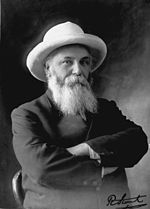
- Arthur Henry Adams,journalist and writer
- Barbara Anderson,novelist
- Rui Maria de Araújo,Prime Minister of Timor-Leste
- Annette Baier,moral philosopher
- Rayyanah Barnawi,Saudi astronaut
- Muriel Bell,nutritionist and medical researcher
- David Benson-Pope,politician
- W. D. Borrie,demographer
- Christine Jensen Burke,mountain climber
- DameSilvia Cartwright,Governor General
- Brian Christie,neuroscientist
- Nathan Cohen,world champion and Olympic champion rower
- John Coverdale,academic psychiatrist
- John Crump,infectious diseases specialist
- David Cunliffe(Carrington), politician
- Helen Danesh-Meyer,ophthalmology academic
- Thomas Davis,politician, diplomat and researcher
- Glen Denham,Tall Black
- Derek Denny-Brown
- Sarah Derrett,injury prevention specialist
- Archibald DurwardFRSE,anatomist
- Marc Ellis(University College),All Black

- Bill English(Selwyn), 39thPrime Minister of New Zealand
- Solomon Faine,microbiologist
- Janet Frame,writer
- Ian Fraser,broadcaster
- Caroline Freeman,first female graduate of the University of Otago
- William Fyfe,geochemist
- Jon Gadsby,comedian and actor
- John Gallas,poet and educator
- Abe Gray,founder of theWhakamana Cannabis Museum,high-profile cannabis activist and protester for almost two decades[98]
- SirHarold Delf Gillies,plastic surgeon
- SirMalcolm Grant(Selwyn), lawyer and Vice-Chancellor ofUniversity College London(2003–13); subsequently Chairman ofNHS Englandand Chancellor of theUniversity of York
- Stephen Guest,legal academic
- Geoffrey HardingOAM,medical practitioner
- Graeme Hart,businessman
- Volker Heine,physicist
- Jan Hellriegel,singer/songwriter
- Greg Henderson,cyclist
- Sir Peter Buck,doctor, military leader, health administrator, politician, anthropologist and museum director.
- Brent Hodge(Cumberland), director


- Fergus Hume,novelist
- Ludwig Keke,Nauruan politician[109]
- David Kirk(Selwyn),All Blackcaptain and businessman
- Josh Kronfeld(Aquinas College), All Black
- Chris Laidlaw,All Black and politician
- Samuelu Laloniu,Permanent Representative ofTuvaluto the United Nations
- Michael Laws,(Arana) politician, writer, broadcaster
- Tania Lineham,science teacher, winner of the Prime Minister's Science Teacher Prize, 2015
- Bridie Lonie,artist and art academic
- John Edward "Jack" Lovelock,athlete
- Chris Mahony,World Bankprofessional,University of Oxforddoctorate, athlete
- Dee Mangin,David Braley Nancy Gordon Chair in Family Medicine atMcMaster University
- Kamisese Mara(Knox), politician
- Diana Martin,microbiologist in New Zealand (1942–2019)
- Stella Maxwell,fashion model
- Dame Judith Mayhew Jonas,businesswoman
- Archibald McIndoe,plastic surgeon
- Joseph William Mellor,chemist
- James S. Milne,mathematician
- Arnold Nordmeyer,politician
- Christopher Norton,composer
- Anton Oliver(University College), Captain of theAll Blacks
- Mazlan Othman,astrophysicist, Director of the United Nations Office for Outer Space Affairs

- Lan Pham,politician and ecologist
- Lord Porritt(Selwyn), Olympian, physician to the Queen andGovernor General
- Arthur Prior,philosopher
- Lauren Kim Roche,physician and author
- Emily Siedeberg,first female medical graduate
- Penny Simmonds,politician
- Robert Stout(Aquinas), Prime Minister of New Zealand
- Sulaiman Daud,politician
- Sione Tapa,Tongan Minister of Health
- Peter Tapsell,politician
- Pobert H WadeLSE Professor
- Jeremy Waldron,legal philosopher
- Murray Webb,cricketer and caricaturist
- Bridget Williams,publisher
- Allan Wilson,molecular biologist
Rhodes Scholars
[edit]list ofRhodes Scholars:

(College at Oxford in brackets)(Source:List of NZ Rhodes Scholars)
- 1907 dColin Macdonald Gilray(University)
- 1923 dRt Hon. Lord Arthur Espie Porritt(Magdalen)
- 1931 dDr John Edward (Jack) Lovelock(Exeter)
- 1932 dSir Geoffrey Sandford Cox(Oriel)
- 1934 dNorman Davis(Merton)
- 1936 dDaniel Marcus Davin[110](Balliol)
- 1952Hon. Hugh Templeton(Balliol)
- 1960 DrJames Julian Bennett Jack(Magdalen)
- 1968Christopher Robert Laidlaw(Merton)
- 1985Dr David Kirk(Worcester)
- 1988Dr Ceri Lee Evans(Worcester)
- 2007Holly Walker(University)
See also
[edit]- University of Otago School of Performing ArtsandAllen Hall Theatre
- List of Honorary Doctors of the University of Otago
- Scarfies
References
[edit]- ^"University of Otago Foundation Trust Annual Report 2021"(PDF).Retrieved1 December2022.
- ^"University of Otago Annual Report 2020"(PDF).Archived(PDF)from the original on 28 July 2021.Retrieved28 July2021.
- ^"Vice-Chancellor's office".University of Otago.Retrieved2 July2024.
- ^abcdef"Quick Statistics about the University of Otago".Archivedfrom the original on 9 February 2013.Retrieved23 October2007.
- ^"Tō Tātou Tuakiritaka | Pride in our identity".University of Otago. 1 May 2024.
- ^"Study at University of Otago, New Zealand | myglobaluni".
- ^abKing, Michael (2003).Penguin History of New Zealand.Penguin Books. p. 209.ISBN0-14-301867-1.
- ^"Our History".otago.ac.nz.University of Otago.Archivedfrom the original on 4 February 2021.Retrieved6 September2016.
- ^"University of Otago, New Zealand".smc.edu.Retrieved1 April2022.
- ^Chilton-Towle, Jonathan (3 March 2014)."Discovering stories behind flat names".Otago Daily Times.Archivedfrom the original on 26 February 2021.Retrieved19 August2016.
- ^Gallagher, Sarah (2013)."Dunedin Flat Names Project".Archivedfrom the original on 17 February 2021.Retrieved18 October2021.
- ^Gallagher, Sarah; Chapman, Ian (2019).Scarfie Flats of Dunedin.Auckland: Imagination Press.ISBN9780995110441.
- ^Secker, Nathan."Scarfie Flats".Te Ara – The Encyclopedia of New Zealand.Archivedfrom the original on 18 December 2012.Retrieved10 October2012.
- ^"Where Did the Word" Breather "Come From?".Critic - Te Ārohi.Retrieved19 December2023.
- ^Paul, Oscar (16 March 2021)."Once students were scarfies, now they're… 'breathers'?".The Spinoff.Retrieved19 December2023.
- ^abMcLintock, Alexander (1966)."Burns, Thomas".Te Ara – The Encyclopedia of New Zealand.Archivedfrom the original on 14 March 2009.Retrieved20 September2008.
- ^abc"History of the University of Otago".University of Otago. Archived fromthe originalon 11 April 2008.Retrieved20 September2008.
- ^"Ethel Rebecca Benjamin".New Zealand Ministry for Culture and Heritage.Archivedfrom the original on 11 August 2016.Retrieved20 September2008.
- ^Mayhew, Judith (4 September 2001)."5th Annual Ethel Benjamin Commemorative Address".New Zealand Law Society.Archivedfrom the original on 8 February 2012.Retrieved1 October2007.
- ^Cooke, Peter D. F.; Crawford, John A. B. (2011).The Territorials: The History of the Territorial and Volunteer Forces of New Zealand.Random House. pp. 136–138.ISBN978-1-86979-446-0.Archivedfrom the original on 6 March 2021.Retrieved9 November2019.
- ^"Dashing heroes of a harbour crossing".Otago Daily Times.6 September 2008.Archivedfrom the original on 17 September 2008.Retrieved20 September2008.
- ^"mystery photographs – University of Otago 1869–2019".Archivedfrom the original on 2 February 2021.Retrieved29 June2016.
- ^"Welcome to the Matariki Network of Universities".Archivedfrom the original on 7 December 2020.Retrieved29 June2016.
- ^"Otago University's culture of control".NZ Herald.9 March 2020.Retrieved17 August2023.
- ^"University reset required".Otago Daily Times Online News.6 April 2021.Retrieved17 August2023.
- ^Taylor, Margot (25 August 2016)."400 protest humanities cuts".Otago Daily Times Online News.Retrieved17 August2023.
- ^Elder, Vaughan (22 February 2017)."Vice-chancellor accused of intimidation".Otago Daily Times Online News.Retrieved17 August2023.
- ^"Opinion: Toxic atmosphere at Otago Uni risks becoming 'chronic'".Otago Daily Times Online News.18 November 2019.Retrieved17 August2023.
- ^"The university's blues".Otago Daily Times Online News.11 March 2020.Retrieved17 August2023.
- ^"Harlene Hayne to leave University of Otago".Otago Daily Times Online News.8 October 2020.Retrieved17 August2023.
- ^MacLean, Hamish (14 October 2020)."Ballantyne chosen for leading uni role".Otago Daily Times Online News.Retrieved17 August2023.
- ^Hudson, Daisy (18 December 2020)."University grad threats: Accused wanted to surpass mosque attacks - police".Otago Daily Times.Archivedfrom the original on 18 December 2020.Retrieved20 December2020.
- ^McNeilly, Hamish (18 December 2020)."Otago uni graduation threat 'surpassed magnitude' of Christchurch terror attack".Stuff.Archivedfrom the original on 18 December 2020.Retrieved20 December2020.
- ^Grey, Edward (14 July 2021)."Woman admits explosives and firearms threat to Otago University graduation ceremony".Stuff.Archivedfrom the original on 14 July 2021.Retrieved16 July2021.
- ^"Otago Uni bomb threat: Woman sent hoax to hide failure from parents".Radio New Zealand.12 May 2023.Archivedfrom the original on 14 June 2022.Retrieved21 May2023.
- ^Kenny, Lee; McNeilly, Hamish (20 April 2023)."Several hundred jobs to go at University of Otago as student numbers plunge".Stuff.Archivedfrom the original on 15 May 2023.Retrieved29 May2023.
- ^"A bright future tipped for the university".Otago Daily Times Online News.7 June 2023.Retrieved17 August2023.
- ^Williams, Mary (27 May 2023)."Looming uni debt plight 'considerable'".Otago Daily Times.Archivedfrom the original on 27 May 2023.Retrieved29 May2023.
- ^Wiliams, Mary (10 May 2023)."'Frustrated' students march against cuts ".Otago Daily Times.Archivedfrom the original on 25 May 2023.Retrieved29 May2023.
- ^Williams, Mary (25 May 2023)."Investigation: Uni budget gap deliberately omitted".Otago Daily Times.Archivedfrom the original on 25 May 2023.Retrieved29 May2023.
- ^Gerritsen, John (27 June 2023)."Big job losses at Victoria and Otago universities to go ahead despite more government funding".Radio New Zealand.Archivedfrom the original on 27 June 2023.Retrieved28 June2023.
- ^abLittlewood, Matthew (20 March 2024)."Vice-chancellor won't be only new face".Otago Daily Times.Archivedfrom the original on 4 April 2024.Retrieved28 March2024.
- ^McNeilly, Hamish (22 April 2024)."'Shame on you': Emails show not everyone happy with Grant Robertson's appointment to Otago Uni's top job ".Stuff.Archived fromthe originalon 22 April 2024.Retrieved24 April2024.
- ^Littlewood, Matthew (17 May 2024)."Otago Uni trust donations plummet".Otago Daily Times.Archived fromthe originalon 16 May 2024.Retrieved19 May2024.
- ^"History of the University of Otago".otago.ac.nz.7 August 2019.Retrieved31 January2022.
- ^"Tuakiritaka".otago.ac.nz.Archivedfrom the original on 29 March 2023.Retrieved1 July2023.
- ^"Otago University unveils proposed new logo".Otago Daily Times.Allied Press.15 March 2023.Archivedfrom the original on 18 March 2023.Retrieved9 April2023.
- ^"New Māori name and symbol proposed for the University of Otago".Stuff.15 March 2023.Archivedfrom the original on 15 March 2023.Retrieved9 April2023.
- ^Ellis, Fiona (17 March 2023)."Majority oppose university logo change".Otago Daily Times.Allied Press.Archived fromthe originalon 24 March 2023.Retrieved9 April2023.
- ^Williams, Mary (6 May 2023)."'The 'perfect storm' facing the University of Otago'".Otago Daily Times Online News.Retrieved27 June2023.
- ^Lewis, John (6 May 2023)."University delays decision on logo".Retrieved26 September2023.
- ^Ellis, Fiona (11 July 2023)."University to go ahead with logo change".Otago Daily Times.Retrieved13 July2023.
- ^"Otago University adopts new logo and Maori name".1 News.TVNZ.11 July 2023.Retrieved13 July2023.
- ^abcde"University of Otago campuses and maps".University of Otago.Archivedfrom the original on 31 March 2019.Retrieved31 March2019.
- ^"Otago University in New Zealand – Beautiful universities around the world".The Daily Telegraph (UK).16 August 2012.Archivedfrom the original on 11 March 2016.Retrieved25 March2016.
- ^"World's most beautiful universities".Huffington Post(UK).2012.Archivedfrom the original on 3 April 2016.Retrieved25 March2016.
- ^Murdoch, David."About the University of Otago, Christchurch".University of Otago, Christchurch.Archivedfrom the original on 31 March 2019.Retrieved31 March2019.
- ^"About the University of Otago, Wellington".University of Otago.Archivedfrom the original on 31 March 2019.Retrieved31 March2019.
- ^"Auckand Centre Home".University of Otago Auckland Centre. 7 June 2017.Archivedfrom the original on 31 March 2019.Retrieved31 March2019.
- ^"Campuses of the College of Education".University of Otago.Archivedfrom the original on 31 March 2019.Retrieved31 March2019.
- ^"Portobello Marine Laboratory Facilities".University of Otago. 8 May 2018.Archivedfrom the original on 31 March 2019.Retrieved31 March2019.
- ^abcd"Library Locations".University of Otago website.Archivedfrom the original on 8 March 2021.Retrieved25 September2013.
- ^"About the University of Otago Library".University of Otago website.Archivedfrom the original on 8 March 2021.Retrieved25 September2013.
- ^"Māori services".University of Otago Library.Archivedfrom the original on 13 October 2018.Retrieved13 October2018.
- ^abMarketing and Communications,University Tour: A Visitor's Guide to the University of Otago,(Dunedin: University of Otago, 2011)
- ^"Law Library, Faculty of Law, University of Otago".University of Otago website.Archivedfrom the original on 17 February 2021.Retrieved25 September2013.
- ^"Hocken Collections, University of Otago".University of Otago website.Archivedfrom the original on 8 March 2021.Retrieved25 September2013.
- ^"The Robertson Library, Dunedin".University of Otago website.Archivedfrom the original on 29 July 2017.Retrieved25 September2013.
- ^"Wellington Medical and Health Sciences Library".University of Otago Wellington.Archivedfrom the original on 31 March 2019.Retrieved31 March2019.
- ^"Canterbury Medical Library".University of Otago Canterbury.Archivedfrom the original on 1 April 2019.Retrieved31 March2019.
- ^"Quick Statistics, University of Otago".Archivedfrom the original on 10 April 2021.Retrieved18 March2021.
- ^"Quick Statistics".otago.ac.nz.Archivedfrom the original on 10 April 2021.Retrieved18 March2021.
- ^"Quick Statistics".otago.ac.nz.Archivedfrom the original on 10 April 2021.Retrieved18 March2021.
- ^Research and Development in New Zealand: A Decade in ReviewArchived13 May 2010 at theWayback Machine.(2006) Ministry of Research, Science and Technology.
- ^"Otago Database Internationally Recognised".Otago Magazine.University of Otago. February 2005. Archived fromthe originalon 14 October 2008.Retrieved6 May2009.
- ^"ARWU World University Rankings 2023".shanghairanking.Retrieved26 August2022.
- ^"QS World University Rankings 2024".topuniversities.19 June 2023.Retrieved26 August2023.
- ^"World University Rankings".timeshighereducation.6 August 2023.Retrieved26 August2023.
- ^"U.S. News Education: Best Global Universities 2022-23".Retrieved23 November2023.
- ^"Top Universities in New Zealand 2018".
- ^"High global rankings".
- ^"University of Otago".
- ^"Subject rankings 2018".
- ^"Otago makes world top 10 university list".28 April 2015.Archivedfrom the original on 8 July 2017.Retrieved29 June2016.
- ^Until 2009, QS and THE had joint rankings, known as theTimes Higher Education-QS World University Rankings
- ^"University of Otago".Quacquarelli Symonds (QS).Archived fromthe originalon 28 September 2012.Retrieved22 May2013.
- ^"New 450-bed residential college proposed for University of Otago".Stuff.23 October 2019. Archived fromthe originalon 23 October 2019.Retrieved25 October2019.
- ^"Otago Uni to build $90m residential hall".Otago Daily Times.23 October 2019. Archived fromthe originalon 25 October 2019.Retrieved25 October2019.
- ^"Seen in Dunedin".Archived fromthe originalon 21 October 2008.Retrieved25 October2007.
- ^"varsity.co.nz:A Student aimed webpage".Archived fromthe originalon 16 October 2007.Retrieved25 October2007.
- ^"Call for end of toga parade after rampage".The New Zealand Herald.26 February 2009.Archivedfrom the original on 11 November 2011.Retrieved26 February2009.
- ^Gallagher, Sarah (2019)."The Debacle" in Scarfie Flats of Dunedin.Auckland: Imagination Press. pp. 166–169.ISBN9780995110441.
- ^Porteous, Debbie (26 March 2012)."Dunedin landlords call for Hyde St keg party ban".nzherald.co.nz.Archivedfrom the original on 11 November 2011.Retrieved23 April2012.
- ^"Cops Control Dunedin Keg Party".The Press.25 March 2012.Archivedfrom the original on 15 June 2012.Retrieved23 April2012.
- ^"Graduation Address 16 December 2006".M.J. Grant.16 December 2006. Archived fromthe originalon 23 December 2007.Retrieved20 September2008.
- ^Dissertation of Kyle Matthews.University of Otago(Thesis). 5 December 2000.Archivedfrom the original on 8 March 2021.Retrieved31 October2013.
- ^P31, Students and the Education Factory: A Marxist analysis of the education crisis, David Colyer
- ^abc"How Abe Gray became New Zealand's 'Gandalf of Weed'".23 October 2020.Archivedfrom the original on 6 March 2021.Retrieved22 February2021.
- ^"Norml Disappointed At University's Change of Heart".Channel 9 Television.Dunedin. 25 July 2007. Archived fromthe originalon 13 March 2009.Retrieved23 May2010.
- ^Rudd, Allison (19 July 2008)."University stays mum over trespass orders".Otago Daily Times.Allied Press.Archivedfrom the original on 3 March 2016.Retrieved23 May2010.
- ^Gibb, John (12 September 2009)."Fifth anniversary of 4:20 protests".Otago Daily Times.Allied Press.Archivedfrom the original on 4 March 2016.Retrieved23 May2010.
- ^"Role of chancellor".University of Otago.Archivedfrom the original on 10 August 2020.Retrieved8 August2020.
- ^Alison Clarke (2018).Otago: 150 years of New Zealand's first university.Dunedin:Otago University Press.ISBN978-1-98-853133-5.OL29404941M.WikidataQ107426622.
- ^ab"Otago University Vice-Chancellor David Murdoch steps down".The New Zealand Herald.14 June 2023.Archivedfrom the original on 16 June 2023.Retrieved19 June2023.
- ^"Vice-Chancellor's office".University of Otago.Retrieved2 July2024.
- ^Fordyce, Evan (2012)."Brian John Marples BA MA MSc FRSNZ FAZ".2000 Academy Yearbook.Royal Society of New Zealand.Archivedfrom the original on 29 May 2014.Retrieved28 May2014.
- ^"Otago announces professorial promotions | Scoop News".Scoop.co.nz. 20 December 2012.Retrieved27 January2018.
- ^"Professor Abigail Smith, Our people, Department of Marine Science, University of Otago, New Zealand".Otago.ac.nz. 16 February 2016.Archivedfrom the original on 14 October 2017.Retrieved14 October2017.
- ^"People".Pacific Islands Monthly(10): 35–36. 1 August 1981.
- ^Two of Dan Davin's novels are set at the University.

